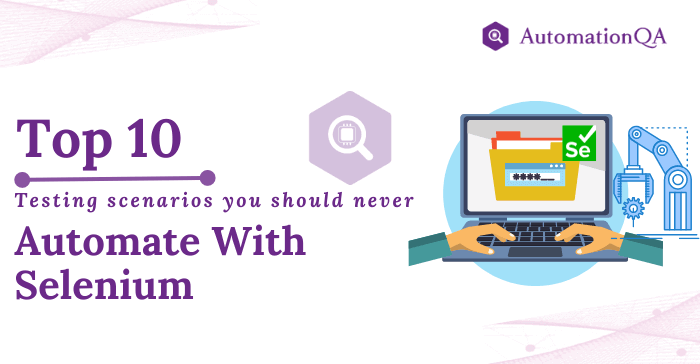
Selenium is an open-source software suite; perfect for automating the testing scenarios of web applications and webpages. When developers automate with Selenium, it supports multiple programming languages to build test cases. That makes Selenium a popular choice for automating web applications.
However, like any other tool, Selenium has its limitations. There are specific testing cases that are best performed manually than automatically. This article will discuss ten such testing scenarios where Selenium should be avoided.
“Selenium may be fast, but it can’t always catch the subtle nuances. Let’s see what are those cases!”
1. Visual Testing
Visual testing is different from UI/UX design testing. It involves checking the appearance of a website, including the layout, images, and colors. This testing is challenging to perform with Selenium WebDriver as it requires a human eye to validate that the website looks as expected. While Selenium can be used to verify that the elements are present on the page, it cannot determine if they are arranged correctly.
2. Exploratory Testing
Exploratory testing is an unscripted and informal testing method where the tester explores the application to find defects. Exploratory testing is an exploratory and spontaneous approach to testing that focuses on finding defects and learning about the software as you go along. This testing type is unsuitable for automation because it requires human creativity, intuition, and problem-solving skills. On the other hand, automated testing scripts are designed to follow a pre-defined set of steps and lack the flexibility and creativity needed for exploratory testing.
3. Usability Testing To Automate with Selenium
Usability testing involves evaluating the ease of use of a website. It evaluates a software product’s usability, accessibility, and overall user experience. This testing type is unsuitable for automation because it requires human interaction and the ability to assess subjective factors such as user satisfaction and comfort level. Automated scripts can only perform pre-defined tasks and cannot judge the overall user experience.
4. Performance Testing
It involves evaluating the performance, speed and responsiveness of a web/mobile application. It requires a different approach, where many virtual users are simulated to test the application’s response to different load levels. Selenium is not designed to handle such scenarios and can only impersonate a single user simultaneously. Additionally, Selenium scripts can be resource-intensive, affecting performance test results’ accuracy. Therefore, developers should never automate with Selenium and use other specialized tools like JMeter or Gatling for performance testing.
5. Security Testing
Developers can only use Selenium for security testing if it involves evaluating the security of an application. Other security testing scenarios require specialized tools and expertise that are beyond the capability of Selenium. While Selenium can automate specific security tests, such as verifying that passwords are encrypted, there are better tools for this type of testing.
6. Link Spidering
Link spidering involves crawling a website to find broken links. This testing is best performed with specialized tools, such as a link checker, making it difficult to achieve with Selenium WebDriver. While Selenium can automate specific link spidering tests, such as verifying that links are working correctly, there are better tools than this type of testing.
7. Accessibility Testing
Accessibility testing involves evaluating the accessibility of a website or web application for disabled people. This testing requires specialized tools and expertise, making it challenging to complete with Selenium. While Selenium can automate specific accessibility tests, such as verifying that alt text is present for images, it is not the ideal tool for this type of testing.
8. Mobile Testing
Developers should never automate with Selenium, as the process of mobile testing involves more than just testing the user interface of an application. It also includes testing the application’s behavior on different devices, operating systems, and network conditions, which cannot be fully addressed using Selenium. Additionally, mobile testing requires access to hardware components such as GPS, camera, microphone, and sensors, which Selenium does not support.
9. Compatibility Testing
Compatibility testing involves evaluating the compatibility of a website on different browsers and operating systems. This testing requires specialized tools and expertise that Selenium does not have. While Selenium can automate specific compatibility tests, such as verifying that elements are present on the page, there are better tools for this type of testing.
10. Test Data Generation
Test data generation involves creating data for use in testing. This type of testing is often performed manually and can be time-consuming. While Selenium can automate specific test data generation tests, such as generating random data, there are better tools for this type of testing.
Conclusion
Indeed, Selenium is a powerful tool with which developers can automate web application testing. It has limitations as its inapplicable to specific testing scenarios where test cases are preferred to be run manually. Visual testing, exploratory testing, usability testing, performance testing, security testing, link spidering, accessibility testing, mobile testing, compatibility testing, and test data generation are all examples of testing scenarios that should be avoided to automate with Selenium. However, developers and software testers should use a combination of manual and automation testing to run test builds efficiently!
Consult with the experts to discover how Selenium Testing can help improve your application performance.
